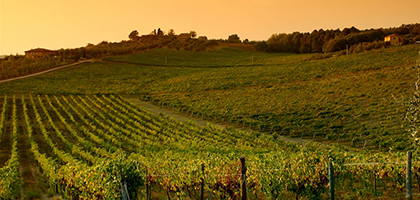CHIANTI CLASSICO
Chianti, the area in which Chianti Classico wine has been produced for centuries, is that part of Tuscany that is bordered to the north by the suburbs of Florence, to the east by the Chianti Mountains, to the south by the city of Siena and to the west by the valleys of the Pesa and Elsa rivers. The area is traversed by the Superhighway of the Palio. It is a land of ancient traditions that was civilized in remote periods first by the Etruscans, who left many traces of their activity in the wine sector, and then by the Romans. In the Middle Ages, the cities of Florence and Siena battled for control over the zone. Villages and monasteries, castles and fortresses appeared during that period and many of them were later transformed into villas and country residences when times were more tranquil. It was then that spaces were cleared in the vast forests of chestnuts and oaks for the cultivation of vines and olive trees, an activity that progressively assumed major economic importance and established an international reputation.
The first notarial document in which the name Chianti appeared in reference to the wine produced in the zone dates to 1398 and in the 17th century exports to England became increasingly frequent. With the agrarian revival in Tuscany in the early 18th century, the sharecropper system came to dominate Chianti and the landscape was enriched because of the different way in which work was organized. Many of the farmhouses, as well as the physical layout of the properties, which has survived, date to that period. From the end of the 19th century to the threshold of the third millennium, Chianti Classico wine has steadily reinforced its position in the affections of wine lovers throughout the world and thereby assured the prosperity and well-being of the region.
Siena and Florence are the capitals of Chianti, which is shared between the provinces of the two communities. The zone amounts to 70,000 hectares (172,900 acres) and includes the entire territories of the communes of Castellina in Chianti, Gaiole in Chianti, Greve in Chianti and Radda in Chianti and parts of those of Barberino Val d’Elsa, Castelnuovo Berardenga, Poggibonsi, San Casciano Val di Pesa and Tavarnelle Val di Pesa. Forests occupy almost two-thirds of the zone. Oaks grow just about everywhere, while chestnuts thrive primarily on the eastern side of the district. Conifers are concentrated at higher altitudes, while stands of pines are common on the low hills to the south of Florence. Wild animals are not as numerous as they once were but it is still possible to observe pheasants, wild boar, hares and roebucks in the zone.
The Chianti wine-producing area was delimited in 1932 by ministerial decree and the boundaries have remained unchanged since then. The decree described the district where Chianti Classico is produced as the “the oldest zone of origin,” thereby recognizing its primacy and according it a special identity. Even at that time, the Chianti territory, as it exists today, was recognized as the original production zone of Chianti Classico wine, a wine that to be distinguished from Chiantis created later and produced in zones different from the Chianti territory, had to be identified by the term “Classico.” Classico means, therefore, “the first” or “the original.”
